The basic concept of load restraint systems outlined in this code of practice is that they should prevent movement of the load under the following conditions:
The following are ways in which the above criteria are met when securing rigid loads (whole bound packets, boxes or crates, etc):
The above is based on the Safety code for timber stacking, packaging and transportation.
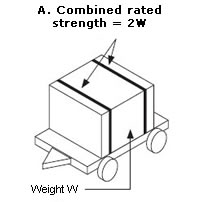
Securing devices (lashings) have a combined rated strength of at least twice the weight of the load where not loaded against a headboard. |
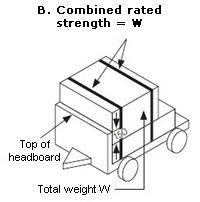
Securing devices (lashings) have a combined rated strength of at least the weight of the load where packets are loaded against a headboard, so that the top packets have at least 150mm supported. |
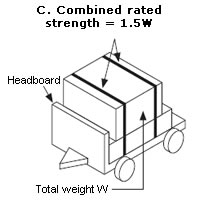
Securing devices (lashings) have a combined rated strength of at least 1½ times the weight of the load where lower packets are supported by a headboard, but upper packets are not supported by at least 150mm. |
Figure 3 Rated strength of vertical securing devices for rigid loads on heavy motor vehicles
For chains and steel wire ropes, the rated strength must be equivalent to not more than the specified minimum breaking force. For webbings and other ropes, the rated (assembly) strength must be equivalent to not more than half the breaking strength. In order that the restraining system is at all times fully effective, it is essential that certain basic requirements are met.
These are outlined below:
In addition to meeting the statutory requirements applicable to the construction, equipment and loading of motor vehicles, the vehicle’s load space and the condition of the platform must be suitable for the type and size of the load to be carried.
A slippery platform surface is always dangerous. The aim should be to obtain the maximum advantage from the frictional restraint by keeping both the base of the load and the platform surface as clean, dry and free from grease as possible. Special precautions should be taken to secure loads when metal-to-metal contact cannot be avoided.
The use of loose dunnage between the load and the platform should be avoided wherever possible. However, where dunnage must be used because of the shape of the load and the need to provide adequate support, this should be selected and secured so as to prevent movement during the journey. Timber dunnage should be of uniform thickness and of the maximum possible width. The minimum width should, where practicable, be twice the thickness. A single layer is preferred to a double layer between the base of the load and the body deck and also between layers of load, if any.
The front of the load should be abutted against the headboard, front rack, or an obstacle fitted transversely across the vehicle platform and firmly attached to the chassis frame. Blocks, wedges and chocks may be used to prevent individual items of a load from moving in any horizontal direction. Care must be taken to ensure that these are strong enough and are adequately secured to the vehicle platform.
The number of anchorage points fitted and used and their strength should be based on the principles outlined in Strength requirements of restraint systems. In the case of those existing vehicles where the provision of such anchorage points is impracticable, adequate load restraint must be achieved by other available means, including baulking. Anchor points that are secured to wooden members only are not likely to be strong enough to provide the restraint required and should be designed to transmit the restraint forces to the vehicle chassis.
Strength requirements of restraint systems
The lashings or fastening devices, twitches and chains, cables, clamps, load binders, etc should be in a sound condition and must be capable of transmitting all the forces likely to be induced in them. The following requirements should be met:
Except in the case of very light bulk loads (0.5 tonne or less), sheets or tarpaulins should be regarded as providing no more than weather protection, and the load must be independently restrained against movement.
The load securing system should be arranged so that it cannot be accidentally released by vibration or movement of the load while the vehicle is in motion.
Dunnage, chocks, etc must be securely restrained when not in use wherever they are placed.
The first priority with any load is to keep within the maximum legal weight limits and vehicle dimensions. The load should be placed against the headboard, provided the handling of the vehicle is not impaired. If the load cannot be placed against the headboard, baulking as described earlier should be used, or twice the strength of lashings are required.
The load should be spread to keep the centre of gravity as low as possible. Where the load is stacked, larger and heavier items should be placed at the bottom (see figure 4).
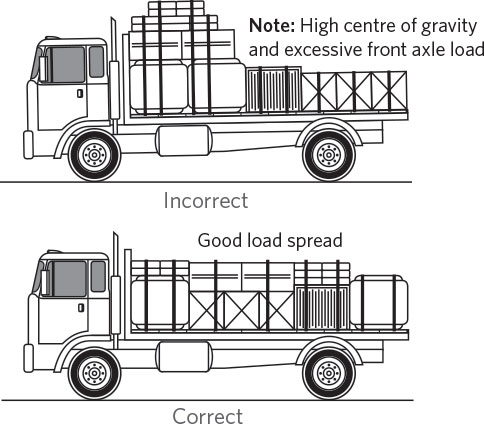
Figure 4
The vehicle should be loaded to give correct axle distribution and an even weight distribution over its floor area (see figure 5). In order to maintain lateral stability, the centre of gravity of the load should be on, or as near as possible to, the centre line of the vehicle.
It is better for heavier items to be carried on the centre line of the vehicle than at the sides.
Heavy solid items should, where possible, be placed in front of light crushable ones or be restrained.
Part loads of heavy solid items should, where possible, be placed over the region of the axles. Do not exceed maximum permitted axle weights.
The load should be placed against the loading rack of the loading platform, or wedged against the rack as shown in figure 5. As far as possible, the load should be redistributed after each partial unloading to maintain the overall balance, ensuring maintenance of drive traction and steerability. The load should not be leant against a rack not designed for that purpose. The weight of heavy loads of small dimensions should be distributed on side members, a platform or a bearer cradle.
A high load will seriously affect the stability of the vehicle and may cause it to overturn when cornering. It is imperative, therefore, that this type of load is carried on vehicles with a low platform whenever possible. Generally, the height of the load must not exceed the length of the load, or be twice the width of the load.
A load must not exceed 3 metres ahead of the front of the driver’s seat or more than the regulations allow behind the rear axis. If it extends more than 1 metre ahead or behind the body of the vehicle, it must have a clean white flag or a red, orange or yellow fluorescent flag attached to the end of the load. It must be at least 400mm × 300mm.
Loads incorporating any dangerous projection should be arranged to minimise risk to the driver and other road users. If progressive unloading occurs, it is essential to resecure the load.
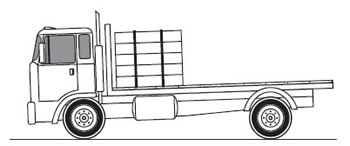
Incorrect loading
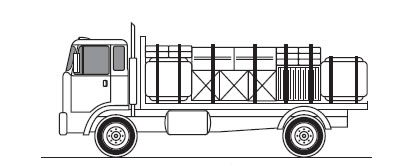
Correct loading
Figure 5
A person mustn’t operate any vehicle if the vehicle and/or its load rise to a height that is liable to cause damage to any construction or wires lawfully over the roadway.
The maximum height for a vehicle to have general access to roads is 4.3 metres. This includes its load and any load securing devices.
For heights above 4.3 metres but less than 5 metres part 3 of schedule 6 of the Land Transport Rule: Vehicle Dimensions and Mass 2016 sets out some specific requirements. For heights above 5 metres a permit is required from Waka Kotahi NZ Transport Agency.